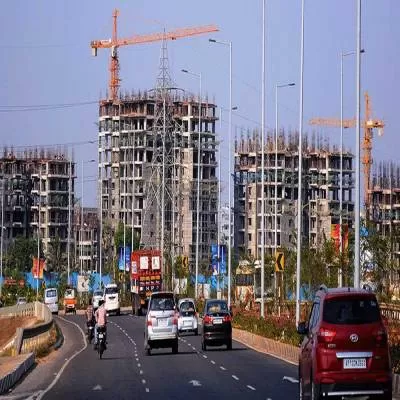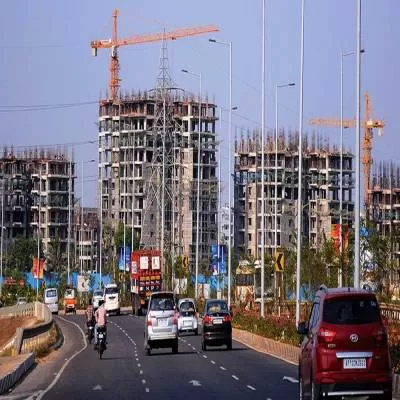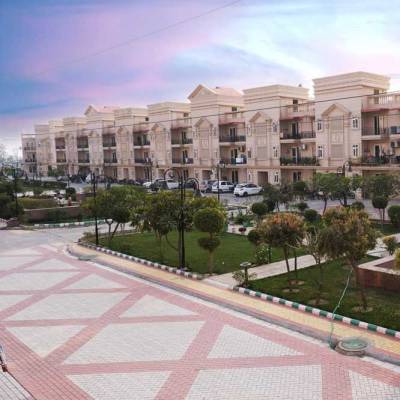- Home
- Real Estate
- Indian Real Estate Sector Set to Reach Market Size of US$180bn by 2020
Indian Real Estate Sector Set to Reach Market Size of US$180bn by 2020
- US$ 20 billion worth REIT-able office stock in India by 2020.
- Housing sector’s contribution to the GDP expected to almost double to 11.2 per cent by 2020.
- Joint Report by CREDAI and JLL titled ‘Traversing through the epic, predicting the curve’ unveiled at CREDAI Conclave 2018 in New Delhi.
CREDAI in association with their knowledge partner JLL jointly unveiled a report titled ‘Traversing Through The Epic, Predicting The Curve’ at CREDAI Conclave 2018 in New Delhi. The report, that traces seven trends that will change the way real estate business will happen in the future in India, highlights that the Indian real estate sector is projected to reach a market size of $180 billion by 2020, a sharp rise from $126 billion in 2015. The report also reveals that the housing sector’s contribution to the Indian GDP is expected to almost double to more than 11 per cent by 2020 up from estimated 5-6 per cent. Regulatory reforms, steady demand generated through rapid urbanisation, rising household income and the emergence of affordable housing and nuclear housing are some of the key drivers of growth for the sector.
According to the report, the ‘architects of changes’ in the form of various revolutionary policies and reforms have paved the way for a highly conducive environment for industry stakeholders which has weaved a new and improved environment for Indian realty, with certain policy based implications expected in the future.
The 7 future altering trends that will transform the Indian real estate sector:
Real Estate Regulatory Act (RERA) – (Key Findings and Projections)
- RERA is expected to consolidate the Indian Real Estate industry with unscrupulous developers to be shunted out.
- Smaller developers in Tier-II and Tier-III cities could tap into institutional funding, if they follow higher disclosure norms and efficient financial management.
Sales figures projected to improve with RERA bound to rebuild the trust deficit between buyers and developers.
Goods and Services Tax (GST) – (Key Findings and Projections)
- The cost savings on account of GST is expected to between 3-4 per cent in the near future as estimated by development community. Prices will continue to remain dependent on demand and supply dynamics within micro-markets.
- The report identifies select cities (other than the top eight cities) and evaluated their potential to become the next growth centre of logistics post GST Implementation. Some of them include Nagpur, Kochi, Chandigarh, Patna, among others.
The recent relaxation in the FDI Policy by the Government of India has also provided a huge boost to the industry in the past, with the report revealing the following findings:
- Private equity and debt investments in real estate increased by 12 per cent YoY across 79 transactions in 2017.
- Investments in retail projects in Tier-I and Tier-III cities reached $6.19 billion in the period of 2006-17.
- Investment inflows in the residential sector since 2014 have been Rs 59,000 crore; approximately 47 per cent of the total invested money in real estate over the same period.
- Private equity inflows in office and IT-ITeS segment for 2014-2017 YTD are 150 per cent higher than the previous seven years’ inflows combined.
Affordable housing is a major theme among investors. With ample policy support, numerous projects are being launched in this sector and FDI will find its way here.
Warehousing and logistics destinations in the country will also be attractive to foreign investors as post GST the sector is getting more organised.
The office segment is likely to remain active in terms of attracting investments.
Affordable Housing
- Create avenue for developers to make strong presence in real estate as demand for this segment.
- Being granted infrastructure status, allows developers to borrow capital at preferred rates as well as utilised secured funding routes for growth.
Real Estate Investment Trust (REITs):
- Over 20 billion worth REIT-able office stock in India with potential rental yield up to 7.5 per cent make Indian real estate very attractive.
- Office REITs may pave the way for Retail asset REITs in the second phase. Higher private equity investment interest in alternative assets such as senior living, student housing. Create a long-term strategy to strengthen development portfolios in those asset classes.
Technology and Use of Prop – Tech
- Tech-enablement of the sector is expected to increase efficiency in building construction, sales and marketing management and property management aspects
- Four big technological revolution that will have lasting change include – Big Data Analytics, Artificial Intelligence (AI) and Internet of Things (IoT) and Block Chain
Alternative Asset Classes
- The real estate sector will benefit greatly from specialisations that are seeing the dawn now. These are expected to pick pace in the next decade
- High growth asset classes for the next decade will be Senior Living, Student Housing and Healthcare.
Ramesh Nair, CEO and Country Head, JLL India, said, “The time for change in now, which is evident in the recent developments. Game changing developments like RERA and GST have created a strong base for the sector to grow, which coupled with India’s strong economic advancement have provided a perfect spring board. Our report ‘Traversing through the epic, predicting the curve’ is focused on providing a sneak peek at the future of the sector, identifying seven trends as mentioned.”
CREDAI Chairman, Getamber Anand, shared his opinion: “CREDAI National has consistently maintained its stance of looking ahead into the future and we continue this trend with the unveiling of the CREDAI-JLL report titled ‘Traversing through the epic, predicting the curve’. The report looks forward in regards to the revolutionary reforms and policy changes that have and will still continue to have a substantial bearing on proceedings. The report reveals some exciting findings pertaining to the growth of the real estate sector which is ought to encourage all industry stakeholders.”
CREDAI President, Jaxay Shah, commented, “As a leading industry body, CREDAI National fully comprehends the prevalent and upcoming industry trends which are bound to have significant implications for Indian realty. Having displayed extreme resilience throughout the course of the past 18 months, the Indian real estate sector is now quite evidently on an upward trajectory backed by the efforts of industry stakeholders and the Government of India. The CREDAI-JLL report ‘Predicting the Curve’ happens to be extremely enlightening and speaks in length of the new era of the Indian real estate sector.”
US$ 20 billion worth REIT-able office stock in India by 2020. Housing sector’s contribution to the GDP expected to almost double to 11.2 per cent by 2020. Joint Report by CREDAI and JLL titled ‘Traversing through the epic, predicting the curve’ unveiled at CREDAI Conclave 2018 in New Delhi. CREDAI in association with their knowledge partner JLL jointly unveiled a report titled ‘Traversing Through The Epic, Predicting The Curve’ at CREDAI Conclave 2018 in New Delhi. The report, that traces seven trends that will change the way real estate business will happen in the future in India, highlights that the Indian real estate sector is projected to reach a market size of $180 billion by 2020, a sharp rise from $126 billion in 2015. The report also reveals that the housing sector’s contribution to the Indian GDP is expected to almost double to more than 11 per cent by 2020 up from estimated 5-6 per cent. Regulatory reforms, steady demand generated through rapid urbanisation, rising household income and the emergence of affordable housing and nuclear housing are some of the key drivers of growth for the sector. According to the report, the ‘architects of changes’ in the form of various revolutionary policies and reforms have paved the way for a highly conducive environment for industry stakeholders which has weaved a new and improved environment for Indian realty, with certain policy based implications expected in the future. The 7 future altering trends that will transform the Indian real estate sector: Real Estate Regulatory Act (RERA) – (Key Findings and Projections) RERA is expected to consolidate the Indian Real Estate industry with unscrupulous developers to be shunted out. Smaller developers in Tier-II and Tier-III cities could tap into institutional funding, if they follow higher disclosure norms and efficient financial management. Sales figures projected to improve with RERA bound to rebuild the trust deficit between buyers and developers. Goods and Services Tax (GST) – (Key Findings and Projections) The cost savings on account of GST is expected to between 3-4 per cent in the near future as estimated by development community. Prices will continue to remain dependent on demand and supply dynamics within micro-markets. The report identifies select cities (other than the top eight cities) and evaluated their potential to become the next growth centre of logistics post GST Implementation. Some of them include Nagpur, Kochi, Chandigarh, Patna, among others.FDI Policy – (Key Findings and Projections) The recent relaxation in the FDI Policy by the Government of India has also provided a huge boost to the industry in the past, with the report revealing the following findings: Private equity and debt investments in real estate increased by 12 per cent YoY across 79 transactions in 2017. Investments in retail projects in Tier-I and Tier-III cities reached $6.19 billion in the period of 2006-17. Investment inflows in the residential sector since 2014 have been Rs 59,000 crore; approximately 47 per cent of the total invested money in real estate over the same period. Private equity inflows in office and IT-ITeS segment for 2014-2017 YTD are 150 per cent higher than the previous seven years’ inflows combined.Key FDI trends that are likely to dominate the future of Indian realty: Affordable housing is a major theme among investors. With ample policy support, numerous projects are being launched in this sector and FDI will find its way here. Warehousing and logistics destinations in the country will also be attractive to foreign investors as post GST the sector is getting more organised. The office segment is likely to remain active in terms of attracting investments. Affordable Housing Create avenue for developers to make strong presence in real estate as demand for this segment. Being granted infrastructure status, allows developers to borrow capital at preferred rates as well as utilised secured funding routes for growth. Real Estate Investment Trust (REITs): Over 20 billion worth REIT-able office stock in India with potential rental yield up to 7.5 per cent make Indian real estate very attractive. Office REITs may pave the way for Retail asset REITs in the second phase. Higher private equity investment interest in alternative assets such as senior living, student housing. Create a long-term strategy to strengthen development portfolios in those asset classes. Technology and Use of Prop – Tech Tech-enablement of the sector is expected to increase efficiency in building construction, sales and marketing management and property management aspects Four big technological revolution that will have lasting change include – Big Data Analytics, Artificial Intelligence (AI) and Internet of Things (IoT) and Block Chain Alternative Asset Classes The real estate sector will benefit greatly from specialisations that are seeing the dawn now. These are expected to pick pace in the next decade High growth asset classes for the next decade will be Senior Living, Student Housing and Healthcare. Ramesh Nair, CEO and Country Head, JLL India, said, “The time for change in now, which is evident in the recent developments. Game changing developments like RERA and GST have created a strong base for the sector to grow, which coupled with India’s strong economic advancement have provided a perfect spring board. Our report ‘Traversing through the epic, predicting the curve’ is focused on providing a sneak peek at the future of the sector, identifying seven trends as mentioned.” CREDAI Chairman, Getamber Anand, shared his opinion: “CREDAI National has consistently maintained its stance of looking ahead into the future and we continue this trend with the unveiling of the CREDAI-JLL report titled ‘Traversing through the epic, predicting the curve’. The report looks forward in regards to the revolutionary reforms and policy changes that have and will still continue to have a substantial bearing on proceedings. The report reveals some exciting findings pertaining to the growth of the real estate sector which is ought to encourage all industry stakeholders.” CREDAI President, Jaxay Shah, commented, “As a leading industry body, CREDAI National fully comprehends the prevalent and upcoming industry trends which are bound to have significant implications for Indian realty. Having displayed extreme resilience throughout the course of the past 18 months, the Indian real estate sector is now quite evidently on an upward trajectory backed by the efforts of industry stakeholders and the Government of India. The CREDAI-JLL report ‘Predicting the Curve’ happens to be extremely enlightening and speaks in length of the new era of the Indian real estate sector.”
























